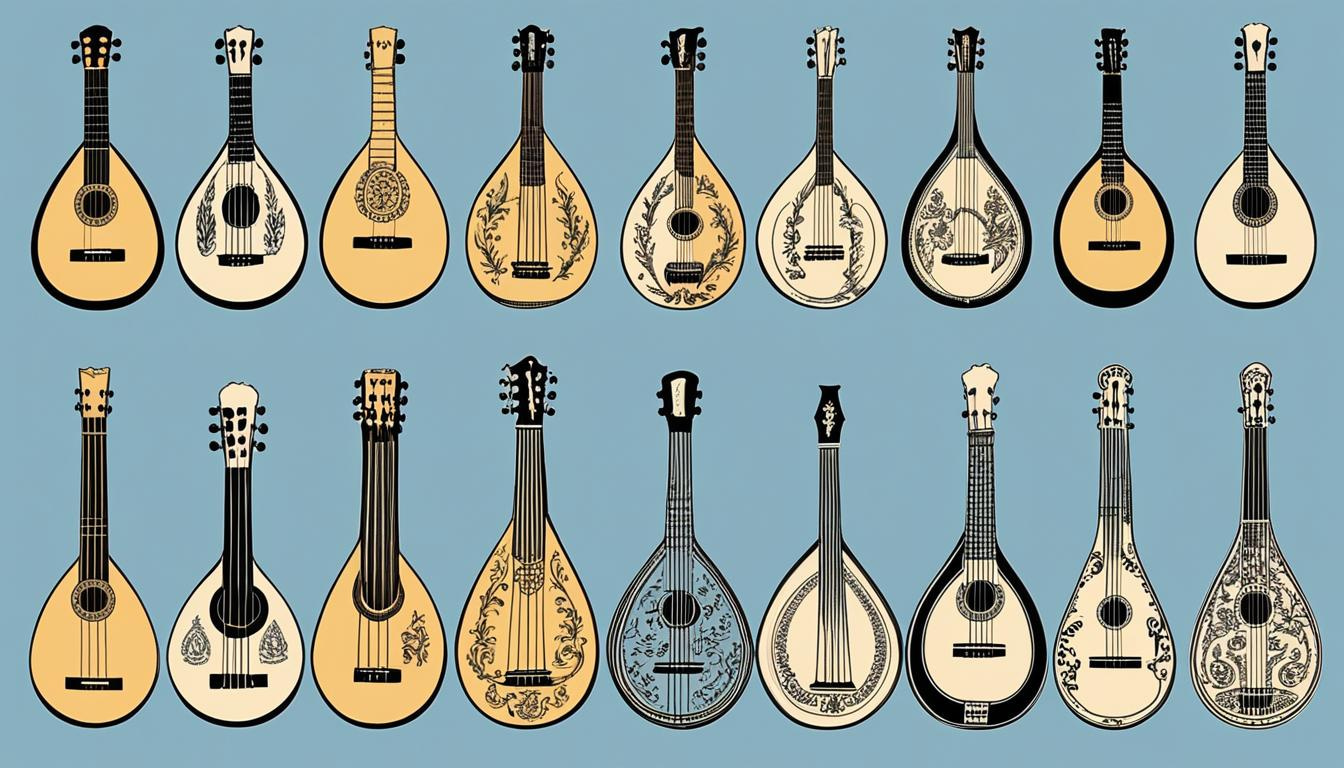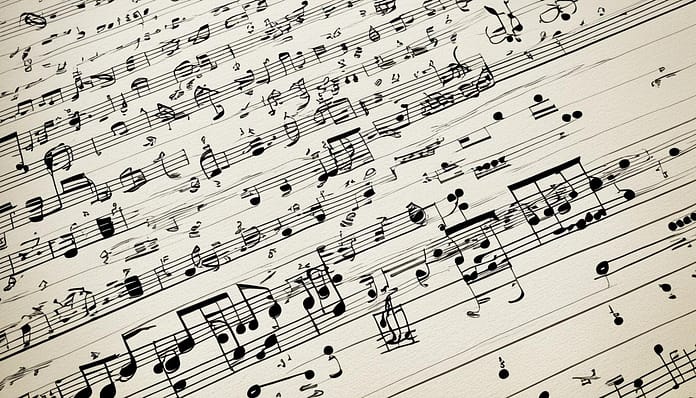This post may contain affiliate links. As an Amazon associate, Google associate as well as associate for other programs, Guitar & Music Institute may earn commissions from qualifying purchases.

The Lute, a classical music instrument and traditional string instrument, has a rich and colorful history that spans centuries. It holds immense historical importance and is regarded as a significant part of the lineage of the guitar. From its ancient origins to its evolution and prominence in Renaissance music, the Lute has left an indelible mark on the world of music. Today, it is still played and celebrated across the globe in huge numbers.
Key Takeaways:
- The Lute has a long and fascinating history, making it a significant classical music instrument.
- It is part of the lineage of the guitar, making it important to guitarists.
- The Lute played a significant role in Renaissance music and has been celebrated by famous lute composers.
- Its origins can be traced back to ancient times, and it has evolved over the centuries into the instrument we know today.
- The Lute’s beauty and cultural importance continue to captivate and inspire musicians and enthusiasts worldwide.
The Lute in Renaissance Europe: A Unifying Musical Tool
By the year 1500, the lute had gained widespread popularity throughout Europe. It became a unifying element of Western music and culture during the Renaissance period. Renaissance composers, singers, and dancers found the lute to be an ideal tool for musical development and maturation. It held great cultural significance and came to symbolize music itself.
The versatility of the lute allowed it to be played as a solo instrument or used for accompaniment in vocal and instrumental ensembles. Its enchanting sounds and expressive capabilities captivated audiences and musicians alike. As it travelled across Europe, the lute became an integral part of courtly entertainment and a symbol of refinement and sophistication.
The lute’s popularity in Renaissance Europe also reflected the period’s artistic and intellectual flourishing. The musical development and experimentation that took place during this time were closely intertwined with the cultural advancements of the era. Renaissance composers, such as John Dowland and Francesco da Milano, penned intricate and emotive compositions specifically for the lute, expanding its potential as a solo instrument.
The lute’s delicate yet resonant tones beautifully captured the spirit and emotions of the Renaissance era, making it a cherished companion in musical performances and intimate gatherings alike.
Furthermore, the lute’s role extended beyond the realm of music. Its significance went beyond its melodic capabilities and connected with the broader cultural landscape of Renaissance Europe. It became a symbol of music and a representation of the era’s artistic and intellectual achievements.
The lute’s cultural prominence in Renaissance Europe continues to resonate today. Its enduring legacy as a unifying musical tool and symbol of creativity and artistic expression solidifies its place in history. From its humble origins to its rise to prominence, the lute remains a testament to the power of music to transcend borders and bring people together.
A Scholarly Journey: “A History of the Lute from Antiquity to the Renaissance”
“A History of the Lute from Antiquity to the Renaissance” by Douglas Alton Smith is a comprehensive book that takes readers on a scholarly journey through the captivating story of the lute. From its origins in Classical Greece to its golden age in Renaissance Europe, this book explores every aspect of the lute’s development with remarkable depth and expertise.
Smith’s meticulous research and insightful analysis bring to life the evolution of this classical music instrument, making it an invaluable resource for anyone interested in the lute’s rich history. Through the inclusion of detailed illustrations and musical examples, the reader gains a deeper understanding of the lute’s significance in both historical and musical contexts.
As a standard reference in the field, “A History of the Lute from Antiquity to the Renaissance” provides a comprehensive and authoritative account of the instrument’s journey. Whether you are a lute enthusiast, a musician, or a music scholar, this book is an essential addition to your collection.
With its meticulous scholarship and engaging storytelling, “A History of the Lute from Antiquity to the Renaissance” offers readers an immersive exploration of the lute’s fascinating story. It is a must-read for anyone seeking a deeper appreciation of this extraordinary instrument and its enduring legacy in the world of music.
Evolution of the Lute: From Arabic Origins to European Adaptations
The fascinating evolution of the lute can be traced back to its Arabic origins. The Arabic lute, also known as the oud, was introduced to Europe through the Moorish conquest of Spain in the 9th century. This pivotal moment in history marked the beginning of the lute’s journey towards becoming a prominent instrument in European music.
As the Arabic lute made its way into Europe, it underwent significant adaptations. European luthiers and musicians embraced the instrument, leading to the emergence of distinct European lute forms in the 14th century. These variations in design and construction allowed for the exploration of new sounds and techniques.
One of the notable changes during the lute’s evolution was the development of playing techniques. Originally played with a quill plectrum, the European lute gradually shifted to plucking the strings with finger tips. This transition, which took place in the 15th century, enabled lutenists to achieve a greater range of expression and control over the instrument’s sound.
“The evolution of the lute highlights the cultural exchange and musical cross-pollination between the Arabic and European worlds. It represents a fusion of traditions that resulted in a unique instrument with its own distinct characteristics and playing style.” – Lute Historian
Throughout its evolution, the lute’s adaptability and versatility allowed it to become an integral part of music across different regions and time periods. Its journey from its Arabic origins to European adaptations speaks to the instrument’s enduring appeal and cultural significance.
A Wealth of Notation Systems: Tablature and Intabulation
The lute, being a versatile and complex instrument, has had various notation systems throughout its history. These systems were developed to allow composers and musicians to accurately write and interpret music written for the lute. One such notation system is tablature, which uses a unique set of symbols and notations to represent the strings and frets of the lute.
During the late 15th century, two prominent tablature systems emerged: “French” tablature and “German” tablature. The “French” tablature utilized lines and letters to represent the strings and frets of the lute, making it easier to read for those familiar with staff notation. On the other hand, the “German” tablature used different symbols for each intersection of string and fret, providing a more intuitive representation of finger positions on the instrument.
These tablature systems were widely used by lutenists and composers until the late 16th century when the first printed book on lute music was published. This marked the introduction of “Italian” tablature, which further refined the notation system by incorporating both the “French” and “German” approaches. “Italian” tablature used numbers to represent the frets and letters to indicate the strings, providing a comprehensive and standardized system for music written for the lute.
The evolution of tablature and intabulation systems throughout the history of the lute showcases the ingenuity and adaptability of musicians and composers. These notation systems enabled them to express their musical ideas and compositions accurately, regardless of the intricate nature of the instrument. Today, the study and understanding of lute notation and tablature continue to be essential for those seeking to explore the rich repertoire of music written for this enchanting instrument.

Varying Sizes and Shapes: The Lute’s Physical Evolution
The lute, with its rich history and cultural significance, has undergone a fascinating physical evolution over the centuries. Paintings from the 16th century depict a variety of sizes and shapes of lutes, showcasing the diversity and versatility of this classical music instrument.
During this time, lutes typically had six courses, which were sets of paired strings. However, in around 1580, the earliest surviving lutes with seven courses emerged, adding an additional layer of complexity and range to the instrument.
As the 16th century progressed, lutes continued to evolve, with the addition of bass strings. This resulted in lutes with a greater number of courses, such as ten courses, particularly in the bass, becoming more common by 1610.
The varying sizes and shapes of lutes not only contributed to their visual appeal but also had a profound impact on the instrument’s tonal capabilities. Each size and shape produced different timbres and textures, allowing musicians to explore a wide range of musical expressions.
By embracing different lute sizes and shapes, musicians could create a diverse repertoire, enabling them to captivate audiences with nuanced performances. The evolution of lute sizes and shapes played a pivotal role in the instrument’s continued growth and relevance throughout history.
Lutes for Accompanying Voices and Instruments
In parallel with developments in solo lute playing, lutes were also adapted for accompanying voices and other instruments. This expansion of the lute’s role allowed it to become an integral part of musical ensembles and compositions.
During the late 16th century, two notable variations of the lute emerged: the chitarrone and the tiorba. The chitarrone was a bass lute tuned to a higher pitch, providing a broader range of harmonies and supporting different musical parts. It became particularly popular in Italian music.
The tiorba, on the other hand, featured an extended neck and a separate pegbox for the bass strings. This design allowed for an increased range and richer resonance, making it ideal for accompanying voices or other instruments.
Another instrument that came into existence during this period is the arciliuto, also known as the archlute. Developed to combine the virtues of normal lute tuning with the powerful basses of the theorbo, the arciliuto became a versatile instrument for both solo and ensemble performances.
“The chitarrone, tiorba, and arciliuto added new dimensions to the lute family, enabling lutenists to create intricate harmonies and provide a strong foundation for vocal and instrumental compositions.” – Lute Historian
These accompanying lutes played a crucial role in the musical landscape of the late 16th century, adding depth and complexity to compositions. The extended neck, alternate tunings, and increased resonance of these instruments allowed for greater tonal possibilities and enhanced musical expression.
The Lute’s Influence and Decline: Baroque Period and Beyond
During the Baroque period, the lute’s role shifted from a solo instrument to an accompaniment instrument. As the era focused more on polyphony and elaborate compositions, the lute became a valuable accompaniment instrument, providing harmonic support for vocal and instrumental performances. Its delicate yet resonant tones added depth and texture to the music of the time.
However, with the rise of the harpsichord and later the piano, the popularity of the lute began to decline. The harpsichord’s ability to play dynamic variations and the piano’s wider range and versatility overshadowed the lute’s modest sound. The lute gradually faded from the spotlight, and its prominence as a primary instrument waned.
Despite its decline, the lute’s influence in the Baroque period was far-reaching. The instrument continued to be featured in various compositions, especially in chamber settings and ensemble performances. Many iconic Baroque composers, such as Johann Sebastian Bach, composed music for the lute, showcasing its unique timbre within larger musical arrangements.
The lute’s legacy can also be seen in the extensive body of written music that has survived from the medieval, Renaissance, and Baroque periods. While the instrument may have lost its popularity in terms of widespread usage, its historical significance remains intact. The lute’s delicate and intimate character, combined with its ability to evoke depth of emotion, continues to captivate modern audiences and inspire musicians alike.
The Ongoing Debates: Origins and Evolution of the Lute
Historians and enthusiasts continue to debate the origins and evolution of the lute. This ancient instrument has a fascinating history that spans continents and cultures. One of the key debates centers around the lute’s origins and the relationship between the long-necked lute and the short-necked lute.
The long-necked lute, traced back to ancient Egypt, is believed to be one of the earliest ancestors of the instrument. Paintings and artifacts from ancient Egyptian tombs depict musicians playing a similar-looking instrument with a long neck and a rounded body. The influence of Egyptian origins on the lute cannot be ignored, as it laid the foundation for its evolution.
On the other hand, the short-necked lute was introduced to Europe through the Moorish influence. The Moors, who conquered Spain in the 9th century, brought with them their own musical traditions and instruments. It is believed that they introduced the short-necked lute to Europe, which eventually evolved into the lutes we are familiar with today.
The relationship between the long-necked lute and the short-necked lute is a point of contention among scholars. Some argue that the two instruments are closely related, with the short-necked lute being a direct descendant of the long-necked lute. Others suggest that the short-necked lute developed independently in Europe, drawing inspiration from various other instruments.
While the debate about the lute’s origins continues, one thing is clear: the lute has left an indelible mark on music history. Its evolution, influenced by both Egyptian and Moorish traditions, has shaped not only the instrument itself but also the music created for it.

The Lute: A Portal to the Renaissance Era
The lute’s ethereal sounds evoke the opulence and elegance of the Renaissance period. Immerse yourself in the complex and emotive compositions that adorned the courts and noble gatherings of this transformative time in history. With Hopkinson Smith’s performance, witness the lute’s power to unlock the mystical beauty of Renaissance music, bringing to life the majesty and grandeur of a bygone era.
“The lute is an instrument that holds a special place in the development of Western music. Through Hopkinson Smith’s skilled interpretation, its enchanting melodies and intricate harmonies will transport you to a world of artistic brilliance and cultural significance.” – Music Enthusiast
The Enduring Legacy of the Lute: An Instrument of Historical Significance
The lute, a classical music instrument of historical significance, has left an enduring legacy on Western music and culture. With ancient origins and prominence in Renaissance Europe, the lute has shaped the course of classical music history. Its distinctive beauty and cultural importance continue to captivate and inspire musicians and enthusiasts today.
From its early beginnings in ancient times to its evolution and popularity during the Renaissance period, the lute has played a vital role in shaping the development of Western music. As a classical instrument, it has not only provided a unique sound but also served as a symbol of cultural identity and artistic expression.
The lute’s enduring legacy is evident in its influence on composers, its presence in historical compositions, and its influence on the sound of classical music. Whether it’s the gentle plucking of strings or the intricate melodies being created, the lute’s contribution to classical music cannot be underestimated.
In a world where musical instruments come and go, the lute has stood the test of time, leaving a lasting impact on the cultural landscape. Its historical significance, as well as its classical beauty, make it an instrument that continues to be cherished and celebrated by musicians and audiences alike.
Source Links
- https://www.pcmsconcerts.org/blog/on-the-origins-of-the-lute/
- https://luteshop.co.uk/articles/lutehistory/
- https://lutesocietyofamerica.org/a-history-of-the-lute/
This post may contain affiliate links. As an Amazon associate, Google associate as well as associate for other programs, Guitar & Music Institute may earn commissions from qualifying purchases.



















